Scratch Mega Blast Original Design / Scratch Built
Scratch - Mega Blast {Scratch}
Contributed by Douglas Gardei
| Manufacturer: | Scratch |

The MegaBlast is my first High Power rocket of my own design. This is the "journal" of its construction. Hold your mouse over the photo to read the description. Click on the photos to view the larger picture.
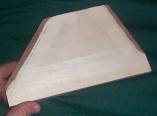
 The MegaBlast is
constructed out of LOC 4" tubing, and uses a single 38mm H motor.
Original, my plans called for 1/8" plywood fins, but I could not find any
sheets that were not warped. So I decided to go with 1/4" plywood. The
fins were cut using a razor saw. After all three fins were cut, it was time to
do the air foiling. I marked where I wanted the tapers to begin, and used
masking tape as a guide. I clamped a belt sander to the workbench, and used it
to taper the leading and trailing. I was impressed how well I did on the
tapers. I guess building the THOY Phoenix a couple years ago gave me a lot of
practice.
The MegaBlast is
constructed out of LOC 4" tubing, and uses a single 38mm H motor.
Original, my plans called for 1/8" plywood fins, but I could not find any
sheets that were not warped. So I decided to go with 1/4" plywood. The
fins were cut using a razor saw. After all three fins were cut, it was time to
do the air foiling. I marked where I wanted the tapers to begin, and used
masking tape as a guide. I clamped a belt sander to the workbench, and used it
to taper the leading and trailing. I was impressed how well I did on the
tapers. I guess building the THOY Phoenix a couple years ago gave me a lot of
practice.
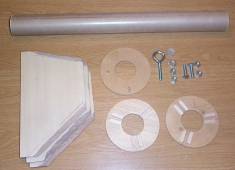 Once the
fins were done, it was time to make the motor tube. I used VCP to print out
some fin location guides and wraps. Since the rocket features T3F, I marked the
fin locations on the motor tube. I also marked the locations on the centering
rings. I drilled holes in the aft centering ring for the motor retention bolts,
and a hole in the forward centering ring for the shock cord anchor.
Once the
fins were done, it was time to make the motor tube. I used VCP to print out
some fin location guides and wraps. Since the rocket features T3F, I marked the
fin locations on the motor tube. I also marked the locations on the centering
rings. I drilled holes in the aft centering ring for the motor retention bolts,
and a hole in the forward centering ring for the shock cord anchor.
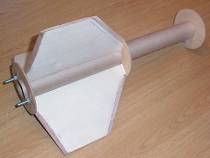 Then, using balsa strips, I glued guides on the two aft centering
rings. The purpose of these guides is to ensure the alignment of the fins, and
to help hold them in place as the epoxy cures. Apparently, everything turned
out great since it can hold itself together without any glue.
Then, using balsa strips, I glued guides on the two aft centering
rings. The purpose of these guides is to ensure the alignment of the fins, and
to help hold them in place as the epoxy cures. Apparently, everything turned
out great since it can hold itself together without any glue.
I used 2 Ton Epoxy to assemble the mount. First I secured the three centering rings. I had the fins in position so the rings would be aligned properly. While waiting for the epoxy to cure, I went ahead and assembled to bulkhead assembly that will join the two sections of the together. After the epoxy cured, I epoxied the fins into their proper position
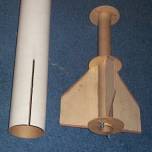
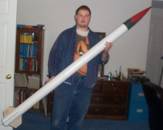 After all the epoxy was cured, I attached the motor
mount to the airframe. Then I used angle bar to draw the slot lines onto the
airframe. I then removed the motor mount, and extended the lines to 8".
Then I used a razor blade to cut out the slots. When all three slots were cut,
I test fitted the whole assembly. I was pleased with the results.
After all the epoxy was cured, I attached the motor
mount to the airframe. Then I used angle bar to draw the slot lines onto the
airframe. I then removed the motor mount, and extended the lines to 8".
Then I used a razor blade to cut out the slots. When all three slots were cut,
I test fitted the whole assembly. I was pleased with the results.
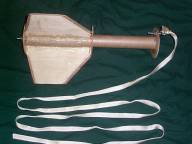 I then took the whole assembly apart and concentrated on finishing
the motor mount. I took some 100 grit sandpaper and roughed up the motor
tube/fin tab joint. I then cut out some fiberglass strips and epoxied them to
the joint. While letting the undercoating of epoxy to soak in, I applied epoxy
fillits to all remaining joints, and installed the shock cord anchor. Epoxy was
used to set the nuts on the eye-bolt. The fiberglass was then coated with
another layer of epoxy. When the epoxy was cured, I used trimmed away any
"hairs" that was sticking out from the fiberglass. Then I attached a
piece of tubular nylon to the shock cord anchor. The motor mount/fin unit is
now finished.
I then took the whole assembly apart and concentrated on finishing
the motor mount. I took some 100 grit sandpaper and roughed up the motor
tube/fin tab joint. I then cut out some fiberglass strips and epoxied them to
the joint. While letting the undercoating of epoxy to soak in, I applied epoxy
fillits to all remaining joints, and installed the shock cord anchor. Epoxy was
used to set the nuts on the eye-bolt. The fiberglass was then coated with
another layer of epoxy. When the epoxy was cured, I used trimmed away any
"hairs" that was sticking out from the fiberglass. Then I attached a
piece of tubular nylon to the shock cord anchor. The motor mount/fin unit is
now finished.
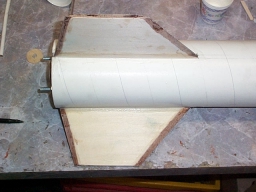 I then took some two ton epoxy, and smeared it 16” inside the
rear end of the tube, and smeared some more epoxy just above the fin slots. I
then inserted the motor mount assembly into the airframe tubing. After the
middle centering ring entered the tube, I added some more epoxy to the end of
the tube. Then I slid the motor mount all the way into the airframe. I then
used the remaining epoxy to saturate the leading and trailing edges of the fins
to make them less prone to denting.
I then took some two ton epoxy, and smeared it 16” inside the
rear end of the tube, and smeared some more epoxy just above the fin slots. I
then inserted the motor mount assembly into the airframe tubing. After the
middle centering ring entered the tube, I added some more epoxy to the end of
the tube. Then I slid the motor mount all the way into the airframe. I then
used the remaining epoxy to saturate the leading and trailing edges of the fins
to make them less prone to denting.
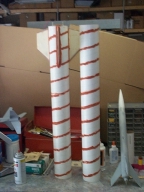 After
the epoxy cured, I sanded all the epoxy on the fins. I then used tissue paper
and a pointed pencil to fill any gaps between the tapers of the fins, and the
square ness of the fin slots. A mixture of 2 ton epoxy and microballons was
then used to create fillits on all the fin and body tub joints. After the
fillets dried, and sanded, I applied the first coat of Bondo glazing and spot
putty to the fin fillets. I also used the Bondo to fill the spiral on the
airframe tubes.
After
the epoxy cured, I sanded all the epoxy on the fins. I then used tissue paper
and a pointed pencil to fill any gaps between the tapers of the fins, and the
square ness of the fin slots. A mixture of 2 ton epoxy and microballons was
then used to create fillits on all the fin and body tub joints. After the
fillets dried, and sanded, I applied the first coat of Bondo glazing and spot
putty to the fin fillets. I also used the Bondo to fill the spiral on the
airframe tubes.
After several application of Bondo, with sanding between each application, the MegaBlast was ready for priming. I used Rust Oleium Grey Automotive primer. The rocket was coated several times with primer, with sanding between each coat. The rocket was now ready to paint, but what colors should I paint it?
At this time, I began to think about using this rocket to obtain my Level 2 certification flight. I passed the written exam at a recent CMASS meeting, and the MegaBlast would make an ideal vehicle to fly on a 38mm J motor. It will go a little over 4,400 ft with a J350 motor… a bit high for the CMASS launch site, but doable for the field in Hallifax, MA. The next Frontier launch was May 25th, 2002. The date was set.
I posted an e-mail on the CMASS mailing list, asking if anybody had any J350’s that they can sell me for my L2 flight. Nobody responded about the J350, but Tony Brock-Fisher replied that he had a J570 load, and asked if I could use that. I loaded up my RockSim file again, selected the J570, “launched” the rocket on the computer… and the software predicted that the rocket would go over 5,650 feet… OVER A MILE!!!! I accepted the motor offer. I then gave a call to Magnum and ordered a Transolve PK Altimeter kit, a new tube coupler, a 45” parachute, and a couple bulkheads. I also went to a local hardware store and bought some threaded rods, bolts, nuts, and other various hardware. It was time to build my first rocket that uses Dual Deployment.
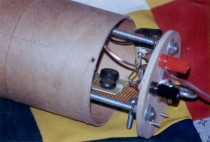 Fortunately, HobbyTown USA in Plaistow NH offered to sponsor my L2 project, so
some of my expenses was covered. Now I have a paint scheme to color my rocket
with… the HobbyTown colors :-). I painted the body of the rocket white,
the nose cone blue, and the fins red. I used black vynal lettering to mark the
name on the rocket, and I used a HobbyTown decal to advertise the sponsor. Now
I must admit that I am a beginner at using electronics in rockets… I have
no experience mounting electronics in the rocket, and this is the first time I
used Dual Deployment. I decided that I wanted the altimeter to go in an
enclosed central modual that can be interchanged easily between 4”
diameter rockets. Both recovery systems will attach to the module, so strength
is important. So I built an assembly that consisted of three threaded rods
connecting two plywood bulkheads. The rods will support the stresses of both
recovery systems. The assembly then slides into a tube coupler, where it is
fastened down with four screws. I was concerned that the wood used for the
bulkheads was on the thin side, but I decided that it was good enough.
Fortunately, HobbyTown USA in Plaistow NH offered to sponsor my L2 project, so
some of my expenses was covered. Now I have a paint scheme to color my rocket
with… the HobbyTown colors :-). I painted the body of the rocket white,
the nose cone blue, and the fins red. I used black vynal lettering to mark the
name on the rocket, and I used a HobbyTown decal to advertise the sponsor. Now
I must admit that I am a beginner at using electronics in rockets… I have
no experience mounting electronics in the rocket, and this is the first time I
used Dual Deployment. I decided that I wanted the altimeter to go in an
enclosed central modual that can be interchanged easily between 4”
diameter rockets. Both recovery systems will attach to the module, so strength
is important. So I built an assembly that consisted of three threaded rods
connecting two plywood bulkheads. The rods will support the stresses of both
recovery systems. The assembly then slides into a tube coupler, where it is
fastened down with four screws. I was concerned that the wood used for the
bulkheads was on the thin side, but I decided that it was good enough.
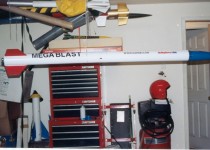 Once the altimeter module was built, it was time to
balance the rocket. I put the rocket together like I was going to fly it. I
loaded the recovery system, and installed the loaded J570 motor. I hung the
rocket on the ceiling, and started adding weight to the nose cone until the
center of gravity was where I wanted it to be. I ended up installing almost a
pound of clay into the nosecone, but the rocket was now balanced. It now
weighed close to 6 pounds empty, a little on the heavy side for a H.
Once the altimeter module was built, it was time to
balance the rocket. I put the rocket together like I was going to fly it. I
loaded the recovery system, and installed the loaded J570 motor. I hung the
rocket on the ceiling, and started adding weight to the nose cone until the
center of gravity was where I wanted it to be. I ended up installing almost a
pound of clay into the nosecone, but the rocket was now balanced. It now
weighed close to 6 pounds empty, a little on the heavy side for a H.
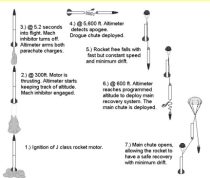 The flight profile of the MegaBlast with a J570 is as
follows. At ignition, the rocket will accelerate off the launch pad quickly. At
300 feet, the altimeter will start keeping track of the current altitude and
engage a 5 second timer. This is called the mach inhibiter, and it prevents the
sudden increase in pressure of the shock wave caused by a object breaking the
speed of sound from fooling the sensor to fire the parachute charges. This
rocket is subsonic, so this feature is not mandatory. After 5 seconds of
flight, the mach inhibitor is turned off, and both charges are armed. When the
rocket reaches apogee (over 1 mile with the J570), the altimeter will deploy
the drogue chute. The drogue chute allows the rocket to freefall in a
controlled manner. When 600 ft is obtained, the altimeter will fire the last
charge to deploy the main chute.
The flight profile of the MegaBlast with a J570 is as
follows. At ignition, the rocket will accelerate off the launch pad quickly. At
300 feet, the altimeter will start keeping track of the current altitude and
engage a 5 second timer. This is called the mach inhibiter, and it prevents the
sudden increase in pressure of the shock wave caused by a object breaking the
speed of sound from fooling the sensor to fire the parachute charges. This
rocket is subsonic, so this feature is not mandatory. After 5 seconds of
flight, the mach inhibitor is turned off, and both charges are armed. When the
rocket reaches apogee (over 1 mile with the J570), the altimeter will deploy
the drogue chute. The drogue chute allows the rocket to freefall in a
controlled manner. When 600 ft is obtained, the altimeter will fire the last
charge to deploy the main chute.
 May 24th came, and I loaded my car with my MegaBlast, and a few other rockets.
I drove 50 miles to Marlbourgh, where I spent the night at a friends house. The
next morning, we traveled the additional 50 miles to the Frontier field in
Hallifax… but I was sick. I only launched one rocket… I decide to
test the altimeter in my EZI-65 with a H242-10T. By the time I got the rocket
back after my first, and successful two stage recovery, I was too sick to fly
any more rockets.
May 24th came, and I loaded my car with my MegaBlast, and a few other rockets.
I drove 50 miles to Marlbourgh, where I spent the night at a friends house. The
next morning, we traveled the additional 50 miles to the Frontier field in
Hallifax… but I was sick. I only launched one rocket… I decide to
test the altimeter in my EZI-65 with a H242-10T. By the time I got the rocket
back after my first, and successful two stage recovery, I was too sick to fly
any more rockets.
 The next
opportunity to launch the MegaBlast came on August 24th, 2002. NAR decided to
accept the Canadian certification of the Pro38 J class motors. I traded my J570
for a Pro38 J285 load and borrowed a case. I also made some minor modifications
to the recovery system. I replaced the 22” Aerotech chute that I was using
as a drogue with a RocketMan 28” X-form chute. I also added a nylon rope
backup to both bungee cords in case they snap. Finally, I bought a $25
Transolve Trans Beep sonic beacon from Magnum to aid in tracking and recovery.
The new altitude estimate for the MegaBlast with the Pro38 J285 is 3,800 -
4,200 feet.
The next
opportunity to launch the MegaBlast came on August 24th, 2002. NAR decided to
accept the Canadian certification of the Pro38 J class motors. I traded my J570
for a Pro38 J285 load and borrowed a case. I also made some minor modifications
to the recovery system. I replaced the 22” Aerotech chute that I was using
as a drogue with a RocketMan 28” X-form chute. I also added a nylon rope
backup to both bungee cords in case they snap. Finally, I bought a $25
Transolve Trans Beep sonic beacon from Magnum to aid in tracking and recovery.
The new altitude estimate for the MegaBlast with the Pro38 J285 is 3,800 -
4,200 feet.
Robert DeHate, Olga Glotova, and Mishka (Olga's friend visiting from Russia) helped me prep the rocket for flight. We placed the rocket on the launch pad, installed the igniter, armed the altimeter, and moved back a safe distance. Robert and Peter Chestna were the witnesses.
5 …. 4 …. 3 ….. 2 ….. 1 ….. KAPLUNK!!!!
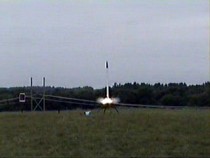
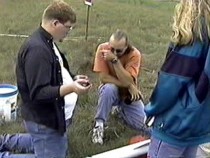 The Pro38 motor detonated. The casing of the motor shot
into the drogue compartment, wedging the recovery system into a tangled mess
inside the tube, causing major damage to the airframe, and completely
destroying the Trans Beep buzzer. The altimeter bay assembly was ripped from
the tube coupler, which confirmed some fears that the thin centering rings and
tube coupler would not hold. The catoing motor also destroyed the motor
retention system, damaged the motor tube, and blew apart the aft centering
ring.
The Pro38 motor detonated. The casing of the motor shot
into the drogue compartment, wedging the recovery system into a tangled mess
inside the tube, causing major damage to the airframe, and completely
destroying the Trans Beep buzzer. The altimeter bay assembly was ripped from
the tube coupler, which confirmed some fears that the thin centering rings and
tube coupler would not hold. The catoing motor also destroyed the motor
retention system, damaged the motor tube, and blew apart the aft centering
ring.
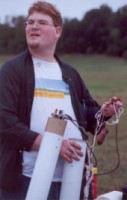 |
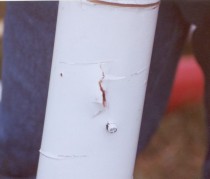 |
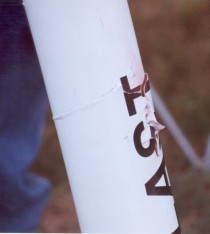 |
 |
Bob Krech and Robert DeHate suggested that we repair the altimeter bay, and use the EZI-65 as a booster, to try again at achieving Level 2. I decided that since I had little over an hour left of the launch, that would be rushing it. I did not want to rush it. To much money is on the line. I told them I did not want to rush it. They agreed.

 Robert DeHate offered to fix the booster for me, and he gave me a J350 reload
to replace the blown J285. He coated the damaged section of the body tube with
fiberglass, and use Kevlar®
to repair the motor tube. I sent the Trans Beep back to Magnum for repairs, and
ordered a LOC 4” Electronics bay. To solve a concern that the shockcord
anchor on the nosecone was not strong enough, I took a pice of tubular nylon,
ran it through the cone, tid several knots in it, rammed the end of the nylon
into the clay, then filled the cone with expanding foam. There is no way this
shock cord anchor is going to fail. I was hoping that the MegaBlast would be
ready to launch again for the September 14th launch. However, the order from
Magnum did not arrive till the 16th, which was the Monday after the launch.
Robert DeHate offered to fix the booster for me, and he gave me a J350 reload
to replace the blown J285. He coated the damaged section of the body tube with
fiberglass, and use Kevlar®
to repair the motor tube. I sent the Trans Beep back to Magnum for repairs, and
ordered a LOC 4” Electronics bay. To solve a concern that the shockcord
anchor on the nosecone was not strong enough, I took a pice of tubular nylon,
ran it through the cone, tid several knots in it, rammed the end of the nylon
into the clay, then filled the cone with expanding foam. There is no way this
shock cord anchor is going to fail. I was hoping that the MegaBlast would be
ready to launch again for the September 14th launch. However, the order from
Magnum did not arrive till the 16th, which was the Monday after the launch.
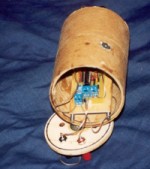
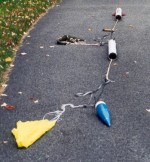 Missing the 14th launch probably worked out for the better anyway. It gave me
time to repair the rocket the way I wanted to. I built the LOC electronics bay
and added some bevels so the bolts have something to screw into besides paper.
I also replaced the nylon rope that I used to back up the bungee cord with
tubular nylon. This stuff is stronger, and less likely to tangle. I also took
advantage of the extra time to get some replacement grains for my J350. The
J350 I had had the 7/16” core in the propellant grain, which has been
known to cato. So I called Aerotech and they ordered me a set of the
½” core grains. I also ordered two inert sets so I could make two
I161 reloads out of the older J350 grains. I managed to get the grains a week
before the Oct 27th CMASS launch. Perfect timing.
Missing the 14th launch probably worked out for the better anyway. It gave me
time to repair the rocket the way I wanted to. I built the LOC electronics bay
and added some bevels so the bolts have something to screw into besides paper.
I also replaced the nylon rope that I used to back up the bungee cord with
tubular nylon. This stuff is stronger, and less likely to tangle. I also took
advantage of the extra time to get some replacement grains for my J350. The
J350 I had had the 7/16” core in the propellant grain, which has been
known to cato. So I called Aerotech and they ordered me a set of the
½” core grains. I also ordered two inert sets so I could make two
I161 reloads out of the older J350 grains. I managed to get the grains a week
before the Oct 27th CMASS launch. Perfect timing.

 The
weather on the October 27th was perfect. The club was not expecting that many
people to show up to this launch, so they did not set up a launch site for a J
motor. So I set up my Super Pad at the High Power C site, and set up the wires
and battery for the site. Once that was completed, I launched my Electronics
bay on my EZI-65 rocket with an I161-14 motor to test out the altimeter, which
reported 1,500 ft. The flight was perfect, but the Trans Beep buzzer was
damaged during recovery. Then the moment of truth, My L2 flight :-D. Steven Boy
(same guy who did my L1) and Robert DeHate as a witness. The J350 came to life,
and the MegaBlast left my launch pad in a hurry, trailing behind a thick white
smoke trail, and a very loud thunderous roar. The Drogue deployed on time at
2,500 ft, but due to inertia, the main was also deployed. However, the rocket
was recovered, and I passed my Level 2 Cert flight!
The
weather on the October 27th was perfect. The club was not expecting that many
people to show up to this launch, so they did not set up a launch site for a J
motor. So I set up my Super Pad at the High Power C site, and set up the wires
and battery for the site. Once that was completed, I launched my Electronics
bay on my EZI-65 rocket with an I161-14 motor to test out the altimeter, which
reported 1,500 ft. The flight was perfect, but the Trans Beep buzzer was
damaged during recovery. Then the moment of truth, My L2 flight :-D. Steven Boy
(same guy who did my L1) and Robert DeHate as a witness. The J350 came to life,
and the MegaBlast left my launch pad in a hurry, trailing behind a thick white
smoke trail, and a very loud thunderous roar. The Drogue deployed on time at
2,500 ft, but due to inertia, the main was also deployed. However, the rocket
was recovered, and I passed my Level 2 Cert flight!

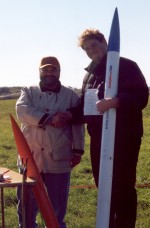 Overall, this project was a success. This was my first
High Power rocket of my own design, and it achieved its purpose. I now have my
level 2 license. What is my future plans. Well, the MegaBlast is a perfectly
good launch vehicle, so I plan to get many more launches out of it. Regarding
my L2? I am thinking about building a LOC Magnum that will air start its
outboard motors. I also might get into the hybrid motors offered by the various
companies out there. I feel that this is necessary due to the increased
regulations on our hobby. When I get my Level 3, I may have to use a hybrid,
since it may be a long time before I can get the unnecessary LEUP to store
those larger motors. And if things go the way they are, maybe even for the
stuff I currently use… but that is another story….
Overall, this project was a success. This was my first
High Power rocket of my own design, and it achieved its purpose. I now have my
level 2 license. What is my future plans. Well, the MegaBlast is a perfectly
good launch vehicle, so I plan to get many more launches out of it. Regarding
my L2? I am thinking about building a LOC Magnum that will air start its
outboard motors. I also might get into the hybrid motors offered by the various
companies out there. I feel that this is necessary due to the increased
regulations on our hobby. When I get my Level 3, I may have to use a hybrid,
since it may be a long time before I can get the unnecessary LEUP to store
those larger motors. And if things go the way they are, maybe even for the
stuff I currently use… but that is another story….
| |
| Olga Glotova – For being a friend, an inspiration, someone to
talk to. Robert DeHate – Your support, advice and effort is so much appreciated. Frank D'Aloisio – Thanks for your support and financial contribution. Ryan Sebastian and Family – For helping me out at the launches. Bob Krech – For supporting my crazy ideas. William Gardei – For talking me out of my crazy ideas. |
Sponsored Ads
 |
 |











